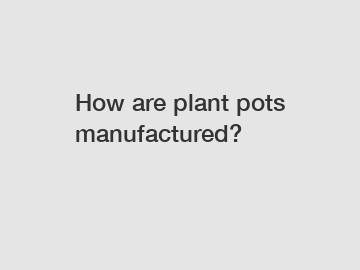How are plant pots manufactured?
Link to OUK
How are plant pots manufactured? A complete guide.
Plant pots are a fundamental element of gardening, allowing plants to be displayed both inside and outside the home. Ever wondered how these essential gardening tools are manufactured? In this article, we will explore the fascinating process of plant pot manufacturing, from raw materials to the finished product. So, let's delve into the world of plant pot production.

1. Raw materials and preparation:
The first step in the manufacturing process of plant pots is the selection of raw materials. Typically, plant pots are made from materials such as clay, ceramic, plastic, or even biodegradable materials. These materials are chosen based on the desired characteristics and functionality of the pots. Once the raw materials are selected, they undergo a preparation process.
2. Mixing and molding:
The raw materials are blended together in precise proportions to create a consistent and even mixture. This mixture is then fed into a molding machine where it is shaped into the desired form of the plant pots. Different mold shapes and sizes can be used, allowing for the production of various types of pots.
3. Drying and firing:
After molding, the plant pots need to be dried to remove any excess moisture. These pots are placed in a drying chamber or kiln, where they are subjected to controlled temperatures. This process ensures that the pots are completely dry and ready for firing. The firing process involves exposing the pots to high temperatures, causing the raw materials to fuse together and become solid.
4. Glazing and decorating:
Once the pots have been fired, they can be glazed to enhance their appearance and functionality. Glazing helps to make the pots waterproof and adds a glossy finish to them. This process involves applying a layer of glaze to the pots and then firing them again. Additionally, manufacturers may decorate the pots with patterns, colors, or even branding to make them more appealing to customers.
5. Quality control:
At every stage of the manufacturing process, strict quality control measures are implemented. This ensures that the plant pots meet the required standards in terms of durability, aesthetics, and functionality. Quality control checks may include scrutinizing the shape and size of the pots, assessing the uniformity of glaze application, and testing the strength of the pot's structure.
6. Packaging and distribution:
Once the plant pots pass the quality control checks, they are ready for packaging. The pots are carefully packed in suitable materials to prevent any damage during transportation. The packaging may vary depending on the type and size of the pots. After packaging, the plant pots are distributed to various retailers, gardening centers, and online stores, making them conveniently available to consumers.
In conclusion, manufacturing plant pots involves a well-structured process that begins with the selection and preparation of raw materials. The mixture is molded into desired shapes, dried, and fired to create sturdy pots. Glazing and decorating add aesthetics, and quality control ensures the finished product meets desired standards. Finally, the pots are carefully packaged and distributed to the market. Next time you admire a plant pot, you'll have a better understanding of the intricate process that brought it to life.
Click here to get more.
Contact us to discuss your requirements of Rectangle Plant Pots Manufacturer. Our experienced sales team can help you identify the options that best suit your needs.



